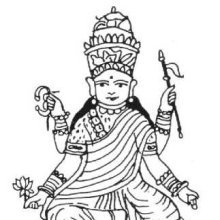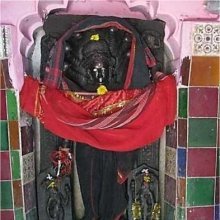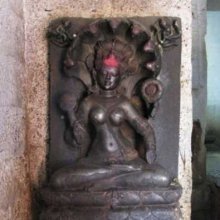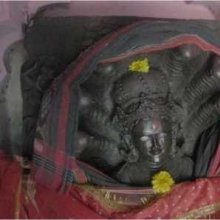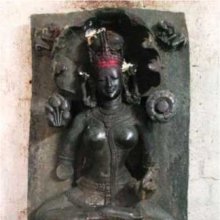Padmavati, Padmāvatī: 31 definitions
Introduction:
Padmavati means something in Buddhism, Pali, Hinduism, Sanskrit, Jainism, Prakrit, the history of ancient India. If you want to know the exact meaning, history, etymology or English translation of this term then check out the descriptions on this page. Add your comment or reference to a book if you want to contribute to this summary article.
Images (photo gallery)
In Hinduism
Purana and Itihasa (epic history)
Source: archive.org: Puranic Encyclopedia1) Padmāvatī (पद्मावती).—A river which is the incarnation of Mahālakṣmī. (See under Gaṅgā).
2) Padmāvatī (पद्मावती).—Wife of Emperor Udayana. (See under Udayana).
3) Padmāvatī (पद्मावती).—Wife of Candragupta son of Sahasramukharāvaṇa. (See under Sahasramukharāvaṇa).
4) Padmāvatī (पद्मावती).—A female follower of Subrahmaṇya. (Chapter 46, Śalya Parva).
5) Padmāvatī (पद्मावती).—Daughter of Satyaketu, King of Vidarbha. Ugrasena married her. After marriage she went and stayed once in her father’s house for a short period. During that time through illegal intimacy with a messenger from Kubera named Gobhila she became pregnant. She started to destroy the foetus when from inside a voice said "I am being born to wreak vengeance on Mahāviṣṇu for killing Kālanemi." The son born thus was Kaṃsa. (Sṛṣṭikhaṇḍa, Padma Purāṇa).
6) Padmāvatī (पद्मावती).—Wife of a Vaiśya named Praṇidhi. Once Praṇidhi went to a neighbouring village for trade. Padmāvatī and her companions were one day bathing in a river nearby when a Śūdra passed that way. Attracted by her dazzling beauty he remained there talking to her. The Śūdra named Dharmadhvaja was greatly enamoured of her and the companions of Padmāvatī, noticing that, just to make fun of him said "If you abandon your life at the point where the rivers Gaṅgā and Yamunā meet you can attain Padmāvatī." Without any hesitation, thinking that what they said was true, he went and ended his life at the place suggested. Immediately he became a replica of Praṇidhi and stood before Padmāvatī. The real Praṇidhi also came there then. Padmāvatī was in a fix to choose the real husband. Mahāviṣṇu appeared before them then and asked Pādmāvatī to accept both of them as her husbands Padmāvatī pleaded it was forbidden for women of her community to accept more than one husband and then Mahāviṣṇu took all the three along with him to Vaikuṇṭha. (Kriyā Khaṇḍa, Padma Purāṇa, Chapter 4).
Source: Cologne Digital Sanskrit Dictionaries: The Purana Index1a) Padmāvatī (पद्मावती).—The city of Purañjaya the capital of the Nāgas.*
- * Bhāgavata-purāṇa XII. 1. 37. Viṣṇu-purāṇa IV. 24. 63.
1b) A daughter of Bhaṅgakāra, who was given in marriage to Kṛṣṇa.*
- * Matsya-purāṇa 45. 21.
Padmāvatī (पद्मावती) refers to the name of a Lady mentioned in the Mahābhārata (cf. IX.45.9). Note: The Mahābhārata (mentioning Padmāvatī) is a Sanskrit epic poem consisting of 100,000 ślokas (metrical verses) and is over 2000 years old.

The Purana (पुराण, purāṇas) refers to Sanskrit literature preserving ancient India’s vast cultural history, including historical legends, religious ceremonies, various arts and sciences. The eighteen mahapuranas total over 400,000 shlokas (metrical couplets) and date to at least several centuries BCE.
Kavya (poetry)
Source: Wisdom Library: Kathāsaritsāgara1) Padmāvatī (पद्मावती) is the name of the seventeenth book of the Kathāsaritsāgara, written by Somadeva in the 11th-century.
2) Padmāvatī (पद्मावती) is the daughter of Pradyota: the king of Magadha who opposed king Udayana, according to the Kathāsaritsāgara, chapter 14. Their story is told by Yaugandharāyaṇa to Rumaṇvat. According to Kathāsaritsāgara, chapter 15, Yaugandharāyaṇa, accompanied by Gopālaka, Rumaṇvat and Vasantaka, devised a scheme to trick king Udayana into believing his wife (Vāsavadattā) was burned at Lāvānaka, so that he would marry Padmāvatī.
3) Padmāvatī (पद्मावती) is the duaghter of Saṅgrāmavardhana from the Kaliṅga country, as mentioned in the first story of the Vetālapañcaviṃśati in theKathāsaritsāgara, chapter 75. Accordingly, “... by lifting up the lotus she let you know her name was Padmāvatī; and by placing her hand on her heart she told you that it was yours... Now there is a king named Karṇotpala in the country of Kaliṅga; he has a favourite courtier, a great ivory-carver named Saṅgrāmavardhana, and he has a daughter named Padmāvatī, the pearl of the three worlds, whom he values more than his life”.
4) Padmāvatī (पद्मावती) is the name of an ancient city situated in Avanti, whose name is associated with the Kṛtayuga, as mentioned in the ninth story of the Vetālapañcaviṃśati in the Kathāsaritsāgara, chapter 83. Accordingly, “... there is in Avanti a city built by gods at the beginning of the world, which is limitless as the body of Śiva, and renowned for enjoyment and prosperity, even as his body is adorned with the snake’s hood and ashes. It was called Padmāvatī in the Kṛta Yuga, Bhogavatī in the Tretā Yuga, Hiraṇyavatī in the Dvāpara Yuga, and Ujjayinī in the Kali Yuga. And in it there lived an excellent king, named Vīradeva, and he had a queen named Padmarati”.
5) Padmāvatī (पद्मावती) is the daughter of Padmaśekhara and is an incarnation of a portion of Gaurī, according to the Kathāsaritsāgara, chapter 115. Accordingly, as Śiva said to Viṣṇu and his companions in Siddhīśvara: “... and he [Candraketu] shall rule the Vidyādharas with that lady, who shall be an incarnation of a portion of Gaurī, and shall be named Padmāvatī, for his consort, and at last he shall come to me. So bear up for a little: this desire of yours is already as good as accomplished”.
The Kathāsaritsāgara (‘ocean of streams of story’), mentioning Padmāvatī, is a famous Sanskrit epic story revolving around prince Naravāhanadatta and his quest to become the emperor of the vidyādharas (celestial beings). The work is said to have been an adaptation of Guṇāḍhya’s Bṛhatkathā consisting of 100,000 verses, which in turn is part of a larger work containing 700,000 verses.
Source: Shodhganga: Mālatīmādhava of BhavabhūtiPadmāvatī (पद्मावती).—Jagaddhara, an old commentator of the Mālatīmādhava identified Padmanagara with Padmāvatī. Also see Padmapura. The scene of Bhavabhūi’s Mālatīmādhava was laid in Padmāvatī. It was stated in this Prakaraṇa itself that a minister of Vidarbha sent his son Mādhava to Padmāvatī with a view to bringing about his marriage with the daughter of the chief minister of that place. It shows that Padmāvatī was not in Vidarbha. The Mālatīmādhava described minutely the environs of Padmāvatī, the rivers such as Pārā, Sindhu, Madhumatī and Lavana flew in its vicinity, the waterfall of the Sindhu and the temple of Śiva situated at the confluence of the Madhumatī and the Sindhu.

Kavya (काव्य, kavya) refers to Sanskrit poetry, a popular ancient Indian tradition of literature. There have been many Sanskrit poets over the ages, hailing from ancient India and beyond. This topic includes mahakavya, or ‘epic poetry’ and natya, or ‘dramatic poetry’.
Chandas (prosody, study of Sanskrit metres)
Source: Shodhganga: a concise history of Sanskrit Chanda literaturePadmāvatī (पद्मावती) refers to one of the twenty-seven mātrāvṛttas (quantitative verse) dealt with in the second chapter of the Vṛttamuktāvalī, ascribed to Durgādatta (19th century), author of eight Sanskrit work and patronised by Hindupati: an ancient king of the Bundela tribe (presently Bundelkhand of Uttar Pradesh). A Mātrāvṛtta (e.g., padmāvatī) refers to a type of metre found in classical Sanskrit poetry.

Chandas (छन्दस्) refers to Sanskrit prosody and represents one of the six Vedangas (auxiliary disciplines belonging to the study of the Vedas). The science of prosody (chandas-shastra) focusses on the study of the poetic meters such as the commonly known twenty-six metres mentioned by Pingalas.
Ayurveda (science of life)
Nighantu (Synonyms and Characteristics of Drugs and technical terms)
Source: WorldCat: Rāj nighaṇṭuPadmavatī (पद्मवती) is another name for Sthalapadmī, a medicinal plant possibly identified with Ionidium suffruticosum Ging., synonym of Hybanthus enneaspermus or “spade flower” from the Hybanthus or “green violet” family of flowering plant, according to verse 5.81-83 of the 13th-century Raj Nighantu or Rājanighaṇṭu. The fifth chapter (parpaṭādi-varga) of this book enumerates sixty varieties of smaller plants (kṣudra-kṣupa). Together with the names Padmavatī and Sthalapadmī , there are a total of sixteen Sanskrit synonyms identified for this plant.

Āyurveda (आयुर्वेद, ayurveda) is a branch of Indian science dealing with medicine, herbalism, taxology, anatomy, surgery, alchemy and related topics. Traditional practice of Āyurveda in ancient India dates back to at least the first millenium BC. Literature is commonly written in Sanskrit using various poetic metres.
General definition (in Hinduism)
Source: Google Books: Costumes and Ornaments as Depicted in the Sculptures of Gwalior MuseumPadmāvatī (पद्मावती).—Pawaya has been identified with Padmāvatī, one of the three captials of the Nāgas, the other two being Kāntipurī and Mathura, as mentioned in the Viṣṇupurāṇa. The Purāṇas, however, give no definite information about the city. The Vāyupurāṇa mentions two houses of the Nāga rulers, one comprising nine kings and ruling at Padmāvatī and the other consisting of seven kings ruling at Mathura.
Source: Kashmiri Overseas Association: Kasheer september 2008 issuePadmavati:—The minister of Udayana are anxious that he begin a series of conquests. They plot to get him married to Padmavati, the daughter of Pradyota, the King of Magadha. Vasavadatta is against it but she is eventually persuaded to agree to this al liance.
In Buddhism
Mahayana (major branch of Buddhism)
Source: Wisdom Library: Maha Prajnaparamita SastraPadmāvatī (पद्मावती) is the name of a universe according to the 2nd century Mahāprajñāpāramitāśāstra (chapter XV). Accordingly, “The universe Houa tsi (Padmāvati) has been mentioned which belongs to the Buddha P’ou houa (Samantakusuma), where the Bodhisattva Miao tö (Mañjuśrī), the Bodhisattva Chan tchou yi (Susthitamati) and other very powerful Bodhisattvas dwell”.
Also, “when the Buddha Śākyamuni transforms the Sahā universe, he gives it a resemblance (sādṛśya) to the Padmāvatī universe. This is why it is compared here to the Padmāvatī universe”.

Mahayana (महायान, mahāyāna) is a major branch of Buddhism focusing on the path of a Bodhisattva (spiritual aspirants/ enlightened beings). Extant literature is vast and primarely composed in the Sanskrit language. There are many sūtras of which some of the earliest are the various Prajñāpāramitā sūtras.
Tibetan Buddhism (Vajrayana or tantric Buddhism)
Source: Wisdom Library: Tibetan BuddhismPadmāvatī (पद्मावती) refers to one of the female Śrāvakas mentioned as attending the teachings in the 6th century Mañjuśrīmūlakalpa: one of the largest Kriyā Tantras devoted to Mañjuśrī (the Bodhisattva of wisdom) representing an encyclopedia of knowledge primarily concerned with ritualistic elements in Buddhism. The teachings in this text originate from Mañjuśrī and were taught to and by Buddha Śākyamuni in the presence of a large audience (including Padmāvatī).

Tibetan Buddhism includes schools such as Nyingma, Kadampa, Kagyu and Gelug. Their primary canon of literature is divided in two broad categories: The Kangyur, which consists of Buddha’s words, and the Tengyur, which includes commentaries from various sources. Esotericism and tantra techniques (vajrayāna) are collected indepently.
In Jainism
General definition (in Jainism)
Source: Wisdom Library: JainismPadmāvatī (पद्मावती) is the mother of Munisuvratanātha, the twentieth of twenty-four Tīrthaṅkaras in Janism, according to the Ācāradinakara (14th century work on Jain conduct written by Vardhamāna Sūri). A Tīrthaṅkara is an enlightened being who has conquered saṃsāra (cycle of birth and death), leaving behind him a path for others to follow. She is also known as Padmā.
The husband of Padmāvatī is Sumitra. It is an ancient Jain practice to worship the Tīrthaṅkara’s parents in various rites, such as the pratiṣṭhāvidhi.
Source: archive.org: The Jaina Iconography1) Padmāvatī (पद्मावती) or Soma is the mother of Munisuvrata: the twentieth of twenty-four Tīrthaṃkaras or Jinas, commonly depicted in Jaina iconography.—Regarding the Jina’s parentage, we are informed that his father named Sumitra was the king of Magadha. His mother had the name of Soma (Padmāvatī according to some books). His dynasty is called the Harivaṃśa. The capital was at Rājagṛha. His name originated from the fact that he kept noble vows (Suvrata, good vows) devoutly and he was a Muni or a Saint.
2) Padmāvatī (पद्मावती) is also mentioned as the Yakṣiṇī accompanying Pārśvanātha: the twenty-third of twenty-four Tīrthaṃkaras or Jinas.—[...] [This?] name of the Yakṣiṇī [viz., Padmāvatī] is common to both the sects. According to the Śvetāmbara view, Padmāvatī is to be represented as riding on a snake and cock, and holding a lotus, noose, fruit and goad. Padmāvatī of the Digambaras is described to be of four types according to the number of hands. Some texts give her a snake and cock as her vehicle, others give her a lotus seat. The four-handed figure holds a goad, rosary, two lotuses. The six-handed type has a nose, sword, spear, crescent, club, staff, as attributes. The eight-handed figure has a noose and other attributes. The twenty-four-handed figure holds a conch, sword, Cakra, crescent, lotus, blue lotus, bow (Śarāsana), spear, noose, Kuśa-grass, bell, arrow, staff, shield, trident, axe, (Kunta) Vajra, garland, fruit, club, leaf, stalk, and Varada-mudrā.
The legend of Padmāvatī is throughout associated with snakes and she belongs to the Nether Regions or Pātāla. This serpent symbol is well manifest in art and so is her other symbol of lotus, which is responsible for the origin of her name. In Bengal, Padmāvatī with the snake-symbols is worshipped as Manasā, the Goddess of snake and the wife of Jaratkāru. Certain vernecular manuscripts called Padma-purāṇa, Behulā-carita (Vipulā-carita also), give the stories of Behulā, Chand Merchant and Padmāvatī. It is most likely that the connection between the Jaina Padmāvatī and the Brahmanic Manasā originates from the Jaina legends. Jaratkāru, an ascetic, stands for Kaṭha in the Jaina legend and it is he who latterly became one with Śeṣa, the King of Pātāla.
Source: archive.org: Trisastisalakapurusacaritra1) Padmavatī (पद्मवती) refers to one of the eight Dikkumārīs living on the western Rucaka mountains (in the Rucakadvīpa continent), according to chapter 1.2 [ādīśvara-caritra] of Hemacandra’s 11th century Triṣaṣṭiśalākāpuruṣacaritra: an ancient Sanskrit epic poem narrating the history and legends of sixty-three illustrious persons in Jainism.—Accordingly, “[...] Eight Dikkumārīs [viz., Padmavatī] also, living on the west Rucaka Mountains, came in haste, as if outstripping each other from devotion. Having bowed to the Jina and the Jina’s mother and having announced themselves as before, they stood behind, holding palm-leaf fans, singing. [...].”.
2) Padmavatī (पद्मवती) is the name of a southern province situated in West-Videha in Jambūdvīpa which is situated in the “middle world” (madhyaloka), according to chapter 2.2.
3) Padmavatī (पद्मवती) is the wife of king Upendrasena from Rājendra, according to chapter 6.3 [ānanda-puruṣapuṇḍarīka-bali-caritra].
4) Padmavatī (पद्मवती) is the wife of king Pratibuddhi from Sāketa, according to chapter 6.6 [śrī-mallinātha-caritra].
5) Padmavatī (पद्मवती) is the wife of king Sumitra from Rājagṛha and was born in the Harivaṃśa lineage, according to chapter 6.7 [śrī-munisuvratanātha-caritra].
6) Padmavatī (पद्मवती) is a Khecara-maiden and the daughter of Sarvaśrī and Surasundara, according to the Jain Ramayana and chapter 7.1 [origin of the rākṣasavaṃśa and vānaravaṃśa].—Accordingly, “One day Rāvaṇa went for amusement to the mountain Megharava which has wings, as it were, with layers of Clouds clinging to its sides. He saw six thousand Khecara-maidens bathing in a pool there like Apsarases in the Ocean of Milk. Desiring a husband, they looked at him with affection, their lotus-eyes wide-open, like day-blooming lotuses looking at the sun. Casting aside modesty at once, afflicted by strong love, they themselves asked him, ‘Be our husband.’ Among these was [e.g., Padmāvatī, daughter of Sarvaśrī and Surasundara, ...]”.
7) Padmāvatī (पद्मावती) is the wife of king Priyamvada from Riṣṭapura, according to the Jain Ramayana and chapter 7.5 [The kidnapping of Sītā].
Source: HereNow4U: Svasti - EssaysPadmāvatī (पद्मावती) is the yakṣī or śāsanadevī who guarded the twenty-third Jina Pārśvanātha, and who continues to guard his tīrtha as embodied in his icons and shrines. She is a goddess who is equally popular in south and north India, and among Digambaras and Śvetāmbaras (Cort 1987: 244-46).
Source: JAINpedia: Women in the Jain tradition: Soḷ satīPadmāvatī (पद्मावती) refers to one of the 16 Satīs mentioned in the Brāhmī Candanbālikā.—In Jain contexts “Satī” revolves around fidelity to the Jain religion. Although Jains call many virtuous Jain women satīs, among Śvetāmbara Jains there is a group of satīs called the soḷ satī or 16 Satīs (i.e., Padmāvatī). These Jain Satīs are revered as role models for women and their stories are widely known. Even though the general group of Satī grows over time, the group of 16 Satīs is unchanging.
Source: academia.edu: Tessitori Collection I1) Padmāvatī (पद्मावती) refers to one of the “sixteen virtuous Jain women”, according to the “Sola satyā” (dealing with the lives of Jain female heroes), which is included in the collection of manuscripts at the ‘Vincenzo Joppi’ library, collected by Luigi Pio Tessitori during his visit to Rajasthan between 1914 and 1919.—There is a list of sixteen virtuous Jain women. [...] These women [e.g., Padmāvatī] are virtuous because they uphold Jain values and could stand to them even in adverse circumstances. Reciting their names is often part of the morning ritual. Behind names are eventful stories that have been told by several writers and read or listened to by Jain followers.
2) Padmāvatī (पद्मावती) is the wife of the merchant Guṇasāgara, according to the “Padmāvatī satī kī vāratā”.—This is not the story of the famous Padmāvatī, wife of king Dadhivāhana, who was carried away in the forest while she was expecting the birth of the future Karakaṇḍu and had to endure several adventures that were challenging for her as a spouse. This one was the wife of the merchant Guṇasāgara. She went abroad with him and met a Yogin who transformed her into an ugly person, etc. Jain signs in the story are: recitation of Navakāramantra, final account of explanatory previous birth by a monk.
3) Padmāvatī (पद्मावती) refers to the Śāsanadevatā (protector deity) of Pārśvanātha, according to the Padmāvatīcaupaī by Jinaprabhasūri (dealing with early teachers, Gods or Goddesses).—Padmāvatī is praised with a devotional tone for her beauty, the powers bestowed to those who gain her favour and the fear these powers may provoke in others. This is done with reference to her bījākṣara in a ‘Tantric’ way. She helps to conquer all kinds of enemies and malevolent beings or other deified figures. She is the protector of the teaching (śāsanadevatā) of the twenty-third Jina, Pārśvanātha, a Jina very often addressed by Jinaprabhasūri. in addition, Padmāvatī had a direct link with the author’s life.

Jainism is an Indian religion of Dharma whose doctrine revolves around harmlessness (ahimsa) towards every living being. The two major branches (Digambara and Svetambara) of Jainism stimulate self-control (or, shramana, ‘self-reliance’) and spiritual development through a path of peace for the soul to progess to the ultimate goal.
India history and geography
Source: archive.org: Personal and geographical names in the Gupta inscriptionsPadmāvatī (पद्मावती) is an example of a feminine name mentioned in the Gupta inscriptions. In feminine names we notice the terminations svāminī and vatī. We find that the feminine names in our inscriptions generally end in ‘ī’. The Gupta empire (r. 3rd-century CE), founded by Śrī Gupta, covered much of ancient India and embraced the Dharmic religions such as Hinduism, Buddhism and Jainism. Derivation of personal names (e.g., Padmāvatī) during the rule of the Guptas followed patterns such as tribes, places, rivers and mountains.
Padmāvatī is also an example of a Vaiṣṇavite name mentioned in the Gupta inscriptions. Classification of personal names according to deities (e.g., from Vaiṣṇavism) were sometimes used by more than one person and somehow seem to have been popular.
Source: What is India: Inscriptions of the ŚilāhārasPadmāvatī is the name of a Goddess mentioned in the “Tālale plates of Gaṇḍarāditya ”. Accordingly, “... to his feudatory Nolamba, who is adorned with all merits, who is the sun that makes the family of the Nigumbas, bloom, who is adorned by his banner of the golden fish and the lordly serpent, who is the very ocean of propriety, (and) who has obtained a boon of the goddess Padmāvatī”.
These copper plates (mentioning Padmāvatī) were discovered by Ramchandrarao Appaji while he was digging in a field at Tālale in the Kolhāpur District. It is dated Tuesday, the tenth tithi of the bright fortnight of Māgha in the expired year 1032 (Śaka), the cyclic year being Virodhin. It records the grants made by Gaṇḍarāditya.
Source: Shodhganga: Mālatīmādhava of Bhavabhūti (history)Padmāvatī (पद्मावती).—It was stated by V. V. Mirashi in his book that Cunningham was the first to make a conjecture about the location of Padmāvatī. He showed that the description suits the town of Narvar lying about twenty miles to the south-west of Gwalior. The river near Narvar was even known as the Sindhu. Pārā was known by the name of Pārvatī. The Madhumatī and the Lavana then bore respectively the names of Mahuvar and Nun. There was an old fort at Narvar. The purāṇas told that nine Nāga kings ruled from Padmāvatī and it was noteworthy that coins of Nāga kings were actually found in the vicinity of Narvar. On this evidence Cunningham identified Padmāvatī with Narvar.
Later, M. B Garde, director of the Archaeological Department, Gwalior state, proved it by Archaeological excavations that Padmāvatī was not identical with Narwar itself but with the village pawaya in its neighbourhood. M.V. Lele had attempted to identify Padmapura, the birth place of Bhavabhūti, with this Padmāvatī.

The history of India traces the identification of countries, villages, towns and other regions of India, as well as mythology, zoology, royal dynasties, rulers, tribes, local festivities and traditions and regional languages. Ancient India enjoyed religious freedom and encourages the path of Dharma, a concept common to Buddhism, Hinduism, and Jainism.
Languages of India and abroad
Sanskrit dictionary
Source: DDSA: The practical Sanskrit-English dictionaryPadmāvatī (पद्मावती).—
1) An epithet of Lakṣmī.
2) Name of a river; Mālatīmādhava (Bombay) 9.1.
3) The goddess Manasā.
Source: Cologne Digital Sanskrit Dictionaries: Edgerton Buddhist Hybrid Sanskrit DictionaryPadmāvatī (पद्मावती) or Padumāvatī.—(1) name of a girl of miraculous birth who became the wife of King Brahmadatta of Kāmpilya; heroine of the ‘Pad(u)māvatī parikalpa’ (colophon Mahāvastu iii.170.10): Mahāvastu iii.155.7 ff. (mss. vary between Padumā° and Padmā°, Senart prints the former); (2) name of a devaku- mārikā in the northern quarter: Mahāvastu iii.309.8 (Padumā°) = Lalitavistara 391.3 (Padmā°, meter rectified by a ‘patch-word’), verse; (3) name of a wife of King Aśoka, mother of Kunāla: Divyāvadāna 405.17.
Source: Cologne Digital Sanskrit Dictionaries: Shabda-Sagara Sanskrit-English DictionaryPadmāvatī (पद्मावती).—f. (-tī) 1. A name of the goddess manasa or the wife of the Jaratkaru. 2. The name of a river, the main stream of the Ganges, between the Kasimbazar river and the sea. E. padma a lotus, matupa aff., fem. aff. ṅīp, and the antepen. made long.
Source: Cologne Digital Sanskrit Dictionaries: Benfey Sanskrit-English DictionaryPadmāvatī (पद्मावती).—i. e. padma + vant + ī, f. 1. A surname of Lakṣmī, [Gītagovinda. ed. Lassen.] 1, 2. 2. A proper name.
Source: Cologne Digital Sanskrit Dictionaries: Cappeller Sanskrit-English DictionaryPadmāvatī (पद्मावती).—[feminine] = padmavatī.
Source: Cologne Digital Sanskrit Dictionaries: Aufrecht Catalogus CatalogorumPadmāvatī (पद्मावती) as mentioned in Aufrecht’s Catalogus Catalogorum:—poetess. One verse of hers in Pmt.
Source: Cologne Digital Sanskrit Dictionaries: Monier-Williams Sanskrit-English Dictionary1) Padmavatī (पद्मवती):—[=padma-vatī] [from padma-vat > padma] f. Name of a wife of Aśoka (cf. padmā-vatī)
2) [v.s. ...] of a town, [Bhāgavata-purāṇa]
3) Padmāvatī (पद्मावती):—[=padmā-vatī] [from padma] f. (cf. dma-v and, [Pāṇini 6-3, 119 etc.]) Hibiscus Mutabilis, [cf. Lexicographers, esp. such as amarasiṃha, halāyudha, hemacandra, etc.]
4) [v.s. ...] a kind of Prākṛt metre, [Colebrooke]
5) [v.s. ...] Name of Lakṣmī, [Gīta-govinda]
6) [v.s. ...] of the goddess Manasā, [cf. Lexicographers, esp. such as amarasiṃha, halāyudha, hemacandra, etc.]
7) [v.s. ...] of one of the Mātṛs attending on Skanda, [Mahābhārata]
8) [v.s. ...] of a Surāṅganā, [Siṃhāsana-dvātriṃśikā or vikramāditya-caritra, jaina recension]
9) [v.s. ...] of a Jaina deity, [cf. Lexicographers, esp. such as amarasiṃha, halāyudha, hemacandra, etc.]
10) [v.s. ...] of a wife of king Śṛgāla, [Harivaṃśa]
11) [v.s. ...] of a w° of Yudhi-ṣṭhira (k° of Kaśmīra), [Rājataraṅgiṇī]
12) [v.s. ...] of the w° of Jaya-deva, [Gīta-govinda]
13) [v.s. ...] of a w° of k° Vīra-bāhu, [Vetāla-pañcaviṃśatikā]
14) [v.s. ...] of a w° of k° Naya-pāla, [ib.]
15) [v.s. ...] of a poetess, [Catalogue(s)]
16) [v.s. ...] of the city of Ujjayinī in the Kṛta-yuga, [Kathāsaritsāgara]
17) [v.s. ...] of another city, [Viṣṇu-purāṇa]
18) [v.s. ...] of a river, [cf. Lexicographers, esp. such as amarasiṃha, halāyudha, hemacandra, etc.]
19) [v.s. ...] of [Kathāsaritsāgara xvii]
Source: Cologne Digital Sanskrit Dictionaries: Yates Sanskrit-English DictionaryPadmāvatī (पद्मावती):—(tī) 1. f. The wife of the sage Jaratkāru; name of a river.
Source: DDSA: Paia-sadda-mahannavo; a comprehensive Prakrit Hindi dictionary (S)Padmāvatī (पद्मावती) in the Sanskrit language is related to the Prakrit words: Paumāvaī, Pomāvaī.
[Sanskrit to German]
Sanskrit, also spelled संस्कृतम् (saṃskṛtam), is an ancient language of India commonly seen as the grandmother of the Indo-European language family (even English!). Closely allied with Prakrit and Pali, Sanskrit is more exhaustive in both grammar and terms and has the most extensive collection of literature in the world, greatly surpassing its sister-languages Greek and Latin.
See also (Relevant definitions)
Starts with: Padmavati-puravala, Padmavaticaupai, Padmavatikalpa, Padmavatipancanga, Padmavatipriya, Padmavatistotra, Padmavatyaradhana.
Full-text (+81): Padmavatipriya, Padmavatipancanga, Padmavatistotra, Padmavatikalpa, Patumavati, Pomma, Padmashekhara, Shikshaniya, Kunala, Padmavati-puravala, Paumavai, Pomavai, Padmanagara, Manasa, Sumitra, Jaratkaru, Godila, Malatimadhava, Behula, Soma.
Relevant text
Search found 49 books and stories containing Padmavati, Padma-vati, Padma-vatī, Padmā-vatī, Padmāvatī, Padmavatī; (plurals include: Padmavatis, vatis, vatīs, Padmāvatīs, Padmavatīs). You can also click to the full overview containing English textual excerpts. Below are direct links for the most relevant articles:
Malatimadhava (study) (by Jintu Moni Dutta)
Part 6 - Economic Condition in the Mālatīmādhava and 8th-century India < [Chapter 3 - Social Aspects of the Mālatīmādhava]
Part 4 - Education System in the Mālatīmādhava and 8th-century India < [Chapter 3 - Social Aspects of the Mālatīmādhava]
Part 1a - The Life of Bhavabhūti < [Chapter 1 - Introduction]
Garga Samhita (English) (by Danavir Goswami)
Verse 2.20.11 < [Chapter 20 - The Rāsa-dance Pastime]
Jainism in Odisha (Orissa) (by Ashis Ranjan Sahoo)
Padmaprabha image, Padmavati Thakurani, Narendrapur < [Chapter 3: Survey of Jaina Antiquities in Odisha]
Jaina Antiquities at Nandapur (Koraput) < [Chapter 3: Survey of Jaina Antiquities in Odisha]
Jaina Antiquities in Kabara (Balasore) < [Chapter 3: Survey of Jaina Antiquities in Odisha]
Trishashti Shalaka Purusha Caritra (by Helen M. Johnson)
Part 2: Previous births of Jaya < [Chapter XIII - Jayacakricaritra]
Part 7: Marriage with Padmāvatī < [Chapter VI - Marriage of Kṛṣṇa with Rukmiṇī and others]
Part 21: Marriage with Padmāvatī and Aśvasenā < [Chapter II - Marriages of Vasudeva with maidens]
A Note on Padmavaty’s Poetry < [October – December, 1995]
Who’s Who Among Our Contributors < [January – March and April – June, 1995]
Who’s Who Among Our Contributors < [April – June and July – September, 1996]
The Padma Purana (by N.A. Deshpande)
Chapter 48 - The Story of Padmāvatī < [Section 2 - Bhūmi-khaṇḍa (section on the earth)]
Chapter 51 - Padmāvatī Returns to Her Husband’s Place < [Section 2 - Bhūmi-khaṇḍa (section on the earth)]
Chapter 49 - Padmāvatī Succumbs to Gobhila’s Fraudulent Approach < [Section 2 - Bhūmi-khaṇḍa (section on the earth)]
Related products
